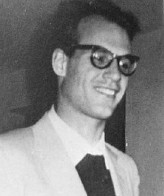

Alexander Grothendieck's father was Russian and he was murdered by the Nazis. Grothendieck moved to France in 1941, and later entered Montpellier University. After graduating, he spent the following year at the École Normale Supérieure in Paris. In 1949 Grothendieck moved to the University of Nancy where he worked on functional analysis with Dieudonné. He became one of the Bourbaki group of mathematicians which included Weil, Henri Cartan and Dieudonné.
Grothendieck spent the years 1953-55 at the University of São Paulo, and then he spent the following year at the University of Kansas. It was during this period that his research interests changed and they moved towards topology and geometry. After leaving Kansas, he returned to France, and in 1959 he accepted a chair in the newly formed Institut des Hautes Études Scientifiques (IHES).
Grothendieck's years 1959-70 at the IHES were a 'Golden Age', during which a whole new school of mathematics flourished under Grothendieck's charismatic leadership. Grothendieck's Séminaire de Géométrie Algébrique established the IHES as a world center of algebraic geometry, with him as the driving force.
During this period, Grothendieck's work provided unifying themes in geometry, number theory, topology and complex analysis. He introduced the theory of schemes in the 1960's which allowed certain of Weil's number theory conjectures to be solved. He worked on the theory of topoi which are highly relevant to mathematical logic. He gave an algebraic proof of the Riemann-Roch theorem. He provided an algebraic definition of the fundamental group of a curve.
The mere enumeration of Grothendieck's best known contributions is overwhelming: topological tensor products and nuclear spaces, sheaf cohomology as derived functors, schemes, K-theory and Grothendieck-Riemann-Roch, the emphasis on working relative to a base, defining and constructing geometric objects via the functors they are to represent, fibred categories and descent, stacks, Grothendieck topologies and topoi, derived categories, formalisms of local and global duality, étale cohomology and the cohomological interpretation of L-functions, crystalline cohomology, standard conjectures, motives and the yoga of weights, tensor categories and motivic Galois groups. He received the Fields Medal in 1966.
Grothendieck was always strongly pacifist in his views and campaigned against the military built-up of the 1960's. To devote himself to this end, he left the IHES in 1970. He abandoned mathematics as the main focus of his energies but held various appointments as professor until he retired in 1988.